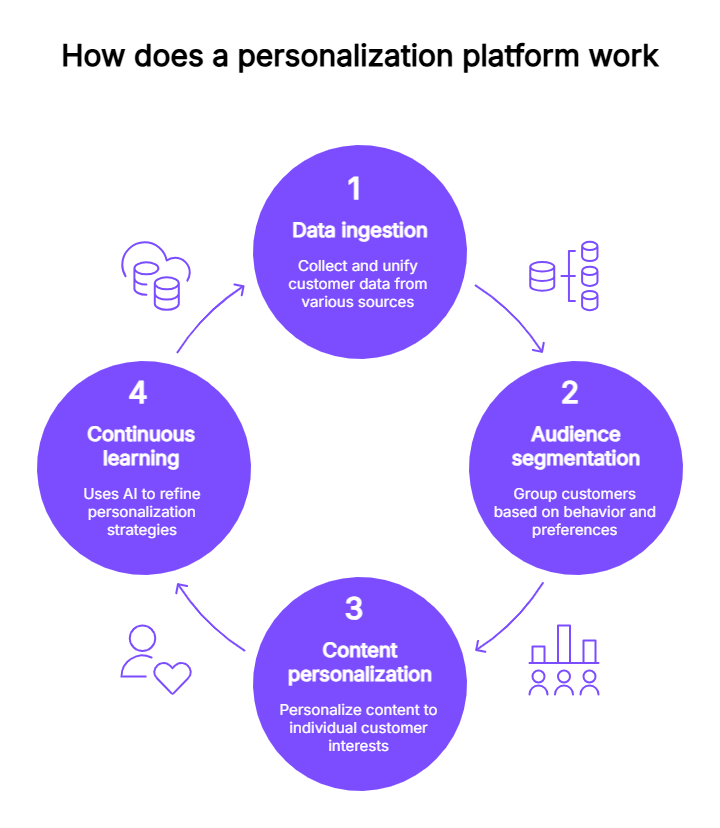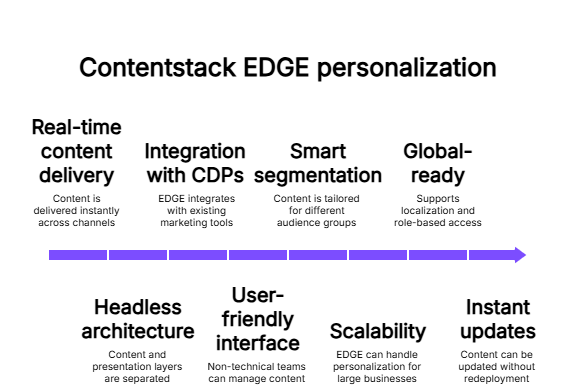Why top brands rely on personalization platforms
Deliver tailored customer experiences at scale with powerful personalization platforms. Learn how tools like Contentstack turn data into real-time, high-impact moments across channels. To wow your audience, start using a platform built for delivering personal experiences.
Highlights
You’ll learn about why you need personalization tools:
- Increases engagement by delivering relevant content and timely offers
- Reduces churn by keeping experiences fresh and customer-centric
- Increases ROI by targeting what resonates
- Gains insights into customer behavior, preferences and intent
- Drives conversions through dynamic, personalized journeys
- Enhances UX across web, mobile and email
You walk into your favorite coffee shop, and before you even say a word, the barista flashes a smile and starts making your usual extra hot, with that perfect cloud of foam. Then they say, “Hey, we’ve got a new sandwich, I think you’ll love it as it’s like the one you ordered last week.” It all feels easy, natural and personal. That’s the kind of personalized shopping experience that stays with you. To deliver such customer experiences, you need personalization platforms.
Personalization platforms are similar to expert concierges, who quietly operate in the background to learn customer needs, design personalized interactions and deliver a unique digital experience. McKinsey further argues that firms that excel in personalization achieve 40% higher sales than their counterparts. It’s essential to know your customers, but proving that you know them at each click, swipe and scroll is what matters most. Personalization today is becoming a proven method of differentiating your brand from competitors and enhancing customer satisfaction.
So, what are these platforms, their types and the role of Contentstack in personalizing every touchpoint?
What are personalization platforms?
Personalization platforms are the tools that make the customer's “aha” moments possible. They quietly pay attention to what customers click on, what they browse and what they buy, and use all that to shape a seamless experience in the moment.
So instead of showing everyone the same offer or message, they talk to your customers, showing what matters most, just when they need it. They are your digital shopkeeper who listens and acts.
Say goodbye to data silos. Contentstack Real-Time CDP empowers marketers with unified profiles and advanced audience targeting. Deliver tailored, real-time engagements that increase ROI and build customer trust.
How does a personalization platform work?
Here’s how personalization software works:
Data ingestion and unification
First, the platform collects data from everywhere: your web, mobile app, CRM, past purchases and email interactions. It combines all these puzzles to create a comprehensive image of every customer. Just imagine that the barista recalls the drink you usually order, your previous snack and the time of the day when you usually show up.
Audience segmentation and profiling
Once the data is in one place, the platform sorts customers into groups, neither by age nor location, but by actual behavior. Perhaps someone browses hiking gear but only makes purchases on weekends. Or maybe they open emails but never click ads. Using these insights, you treat each customer as an individual, rather than a number.
Dynamic content generation and delivery
Depending on the information and data gathered and accumulated, the platform personalizes content for each customer in real-time. It means replacing banners on home pages, product recommendations, email marketing subject lines or app messages with content that individual customers are most likely to show interest in. Your barista is the one who suggests a new sandwich you’re likely to try.

Continuous learning and optimization
Personalization tools are AI or ML-powered. The more the system interacts with customers, the smarter it gets. Every click, scroll or skipped offer helps you in future recommendations. Going back to our earlier example, your barista noticed that you didn’t finish your usual coffee and thus offers a lighter version next time, learning from subtle cues and making smarter decisions over time.
Types of personalization platforms
Each type plays a unique role in crafting experiences that feel personal, relevant and timely. Here are some types:
Headless CMS with personalization capabilities
Like a versatile content engine, a headless CMS with personalization provides content for your website, mobile app and wireless kiosk and also adjusts the content depending on the person viewing it. In contrast, a traditional CMS couples the front-end and the back-end (the processes of updating them are slow, and personalization can be complex). But in a headless CMS, they are separate. This delivers content to multiple channels with speed and future-proofs your personalization strategy. When your customer returns to your site, your CMS knows which customer is returning, what they purchased, where they are located and the device they are using. On obtaining this information, the CMS delivers personalized content.
Customer data platforms (CDPs)
CDP unites and integrates the information from several sources. You acquire customer data from a variety of platforms, such as web and mobile applications, support tickets, emails and face-to-face visits. These platforms provide a 360-degree customer view of every customer. CDPs track behaviors such as purchase history, customer service experiences and customer browsing patterns. Marketers and personalization engines can use this data for customer segmentation to personalize experiences and content.
Content personalization engines
Content personalization engines provide context-aware and targeted content across every digital touchpoint. These platforms incorporate behavioral information, customer segments and predictive modeling to dynamically change what customers see on websites, landing pages, blogs or product pages. They personalize based on when and how customers interact. With personalization engines, you can deliver relevant messages, products or offers in real time.
Marketing automation platforms with personalization
In marketing automation, emails, push notifications, SMS messages and other messages are sent to make customers feel that they are timely and personal. Why? It’s triggered by a particular action the customer takes. Instead of broadcasting the same message to all of them, these tools will understand when one signs up, stops or clicks and does not purchase and push the message at the right time. Most of these platforms include A/B testing, visual journey builders and behavior-driven targeting, allowing teams to build intelligent campaigns without needing to write code continuously or make guesses based on prior experience.
E-commerce personalization platforms
E-commerce personalization software enhances the online shopping experience by making it more personalized. Instead of displaying the same product or offer to all shoppers, these platforms determine what each customer wants to see, based on their previous searches, purchased products or the subsequent purchase they might make.
AI-powered personalization tools
AI-powered personalization tools never rely on fixed rules (“if the customer clicks X, then do Y”). AI-driven tools look for deeper patterns in how customers behave, what they watch, read, scroll past or linger on, and make predictions based on those cues. They use machine learning to understand what someone did, but what they’re likely to do next. That means the content, product or recommendation feels spot-on. The more data the platform sees, the more it learns and the more accurate and relevant the experiences become.
Benefits of personalization platforms
Increases customer engagement
Like a barista who remembers your order, personalization platforms show up for customers in small, meaningful ways. Using personalization software tools, they recommend the right product, surface helpful content or just say the right thing at the right time. When it feels personal, customers remain engaged.
Reduces customer churn rate
So, does a single instance of poor service break a customer’s trust? Probably, yes. But customers also leave when products or services feel generic or irrelevant. Personalization keeps the experience fresh and customized, ensuring customer loyalty and reducing the churn rate.
Offers a higher ROI
Should all your messages reach all your customers? By focusing on the customers who are most likely to care and serving up exactly what they need, you get more return for every campaign, every click and every minute your team invests.
Improves customer insights
Every action a customer takes tells a story. The personalization platforms work as background listeners and benefit with every scroll, tap and browse. With time, they begin to understand patterns, such as what works and what doesn't, and where the opportunities lie.
Drives higher conversion rates
Sometimes, what your customers require is a timely product recommendation, a gentle nudge or a personalized offer to prompt them to make a purchase. Personalization tools can do it without being pushy. Posting valuable and interesting proposals and content, such as valuable advice, leads to a greater conversion rate.
Enhances user experience
Your customers despise being treated like a number. Personalization will make your app, email or webpage more of a conversation rather than a transaction. All it takes is a mere change from generic to genuine content to enhance the user experience.
Key features to look for in a personalization platform
Dynamic content delivery
Look for a platform that personalizes the experience for each person based on their identity and activity. Whether it’s headlines, product offers or even homepage banners, it’s all customized in real time.
Behavioral tracking
Look for tools that track customers’ actions on different pages, devices and sessions and track clicks, exits and time spent on each page. The more you know about your customer actions, the more meaningful your personalization becomes.
Omnichannel personalization
Omnichannel personalization enables you to deliver the same message to customers across all your touchpoints consistently. When your brand sounds consistent regardless of the platform customers use, you achieve a seamless conversation. You will not come across as a business that sends out a series of irrelevant messages.
Offers A/B testing
Personalization is a fusion of knowledge and feeling. A good platform provides an opportunity to explore. You can implement different headlines, pictures, calls-to-action and even entire page designs to determine what resonates with your audience. For instance, one group would be more responsive to strong visuals, while the other would be more responsive to subtle messages. Through A/B testing, you experience actual behavior and adjust each interaction to put customers into the sweet spot.
Customer journey mapping
Knowing the current stage in which your customer is (first visit, mid-consideration, post-purchase) can show the right message at the right moment. Customer journey mapping is an essential feature to look for.
Real-time data analysis
Fast data powers fast decisions. The best platforms track customer behavior as it unfolds, allowing you to adjust offers, content or experiences in real-time, while the moment still matters.
User segmentation and targeting
These tools use predictive, psychographic, behavioral and contextual data for creating hyper-targeted segments. The best platforms group your customers based on real behavior, so that you speak to them based on what matters the most and has nothing to do with who they are.
Top personalization platforms
Contentstack EDGE
Contentstack EDGE is more than just a content delivery engine, as it brings real-time personalization to a headless content management system (CMS). It delivers dynamic and personalized marketing campaigns and content to individual customers, wherever they are. When combined with the composable architecture, Contentstack EDGE enables individualized digital outputs at scale without impacting your systems.
Case study: How did Ello Group deliver personalized experiences at scale with Contentstack?
Ello Group accelerated publishing 10x and improved site performance by 70% after switching to Contentstack’s headless CMS. With reusable components, real-time updates and automation, teams now create and deliver content faster across multiple brands. Personalized experiences and SEO-friendly content increased discoverability and customer engagement. Contentstack empowered Ello to scale with flexibility while prioritizing tailored, high-impact digital experiences.
Read the complete case study here.
Dynamic Yield
Dynamic Yield personalizes every single point of the customer path, like product recommendations, personalized search, custom banners and messages. It’s flexible enough to help marketers experiment and optimize without spending too much time on development.
Personyze
Personyze offers behavior-based, real-time personalization on websites, emails and apps. Using Personyze, you can personalize pop-ups, dynamic banners and emails. The personalization triggers are based on the customer's previous activities or location.
Insider
Insider provides localized experiences to customers across various channels, including web, mobile, email, messaging applications and others. Because of its AI-backed segmentation and predictive features, Insider helps your marketing teams identify the right audiences and connect with customers through personalized content.
Proof
Proof focuses on social proof and personalization for B2B websites. It personalizes content on the websites, depending on who visits it, their industry, company size or behavior, without redesigning the complete site.
How Contentstack’s EDGE personalizes every touchpoint
Contentstack’s EDGE combines speed, flexibility and smart personalization into one seamless platform. Here’s how it connects with every customer exactly where they are:
Real-time content delivery across every channel
Contentstack EDGE delivers personalized content in real-time without delay or compromise in quality.
Headless architecture built for omnichannel
Since the content and presentation layers are separate, your team can personalize content for your web, mobile, wearable devices and even voice interfaces without starting everything from scratch.
Plays with your CDPs and marketing tools
Contentstack EDGE integrates with your existing tools, like customer data platforms and automation software. As a result, you can use rich data to create hyper-relevant experiences.
Friendly for marketers and developers
Contentstack EDGE’s interface is ideal for non-technical teams. Marketers and product managers can launch, update and personalize content without knowing how to code or depending on the development team.
Supports smart segmentation and dynamic content
Contentstack EDGE provides an opportunity to display various offers, headlines or layouts to different groups of audiences in real-time. The platform personalizes the experience for each customer, tailoring what they see, how they behave and how they interact.

Built to scale with your business
It does not matter whether you want to create personalization for 100 or a million customers; Contentstack EDGE can manage any complex personalization across large-scale businesses.
Global-ready with built-in localization and permissions
Target different regions and customer roles with content that feels like it was made just for them. Contentstack EDGE supports localization, translation workflows and role-based access.
Update content instantly, no redeploy needed
Do you want to make a quick change or test a new content version? You can do it without triggering a full website redeploy. Contentstack EDGE ensures faster updates and more agility, especially during high-traffic moments.
Elevate your brand with Contentstack's Real-Time CDP! Experience more intelligent marketing with measurable results. Achieve unique omnichannel personalization backed by AI-driven insights, predictive segmentation, and instant updates.
FAQs
What is a personalization platform?
Personalization platforms are solutions that brands use to make content and experiences tailored to an individual customer based on their clicking, browsing or purchasing preferences.
What are the 4 Ds of personalization?
The 4 Ds of personalization are Data, Decisioning, Design and Distribution.
What is an example of personalization?
Imagine you are purchasing running shoes online. Then, the next time you log in, the website will present you with gear like matching outfits, socks, water bottles, smartwatches, (what you did before) or perhaps an email to look at the size chart or an invitation to run a local race. When you receive such personalization, it makes you feel valued.
Learn more
Some of the most successful digital experiences are the ones that are personalized and optimized based on valuable insights obtained from personalization platforms. Whether it’s a product recommendation that feels spot on or a message that arrives just when it’s needed, personalization platforms help you show up smarter, faster and more meaningfully. With the right tools, such as Contentstack EDGE, you can exceed expectations. And when every click counts, that makes all the difference.
Do you want to create moments your customers will remember? Talk to us to know how we can help.
